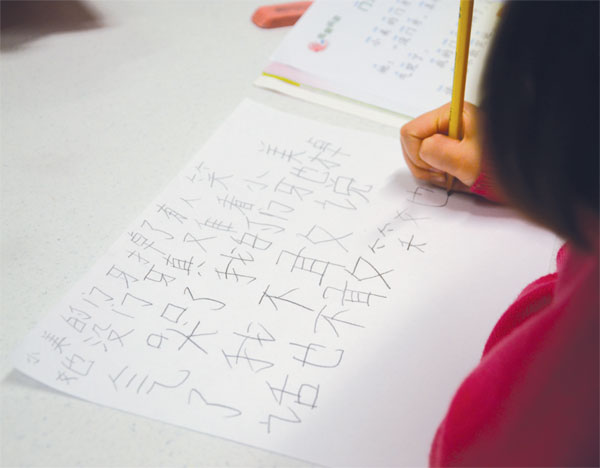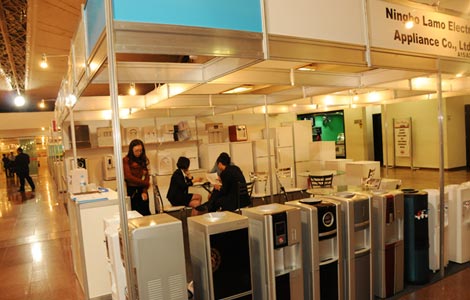Mandarin's moment
Updated: 2014-11-28 11:48
By William Hennelly(China Daily USA)
|
||||||||
|
A pupil copies a Chinese passage from a textbook at the Hudson Way School, New York. Pupils are generally capable of understanding and writing short passages by ages 6-7. |
Going global, too
In Sao Joao da Madei, Portugal, a shoemaking capital, the study of Mandarin is mandatory for 8- and 9-year-olds. The Chinese taste for luxury items extends to fancy Portuguese shoes, which are considered second-best in the world to Italian shoes. The Portuguese deduce that Mandarin will help them expand their shoe market in China, which, according to Agence France-Presse, went from 10,000 pairs in 2011 to 170,000 pairs in 2013.
Recent research by the British Council and Hanban found that 3 percent of primary schools, 6 percent of state secondary schools and 10 percent of independent schools offer Mandarin courses, China Daily reported. Over the next five to 10 years, those numbers are expected to grow by 4 percent to 8 percent.
"I want Britain linked up to the world's fast-growing economies, and that includes our young people learning the languages to seal tomorrow's business deals," UK Prime Minister David Cameron said in 2013.
"By the time the children born today leave school, China is set to be the world's largest economy. So it's time to look beyond the traditional focus on French and German and get many more children learning Mandarin."
In South Korea, the number of people taking the official Chinese proficiency test has risen to 110,000 in 2013 from 400 in 1993.
The ACTFL's latest survey on the number of students taking foreign languages in grades K-12 in the US was conducted in 2007-2008. In that school year, there were 60,000 students studying Mandarin, an increase of 195 percent compared with the 2004-2005 survey, the highest jump of any language.
Shuhan C. Wang, director of the Chinese Early Language and Immersion Network (CELIN) at the Asia Society, estimated that the number is easily above 100,000 now, and counting students of Chinese heritage studying privately, about 300,000, she said.
"Chinese programs are growing," Wang told China Daily. "The field is growing. Because it's growing, we don't have a very good mechanism or money to collect data. All the data is outdated. The American council (ACTFL) data is the latest official data we have.
"In K-12, definitely over 100,000 students taking Chinese, not including Chinese heritage students," Wang said. "That's another 150,000 students. Their home language is Chinese. We have over 250,000 students taking Chinese in the country; over 300,000, including the universities."
Wang said the reasons for studying Chinese or other foreign languages are obvious.
"In order to compete in the global market, you can no longer compete with your neighboring state; instead, you need to compete with your neighboring country or any country in the world where the labor force is cheap - but good," she said. "Global competency has become a very important concept in education, although it has not been as prominent as what we would like to see for the 21st century, but it is coming up."
"Parents and students are looking at bilingualism, especially learning Chinese, as a ticket to future markets and jobs and as an asset for personal human capital," said Wang. "You use the target language, the buyer's language to open the conversation and the market, but you use English to close the deal. Use their language and culture to win their trust and to build relationships, and that's No 1 to opening the market," she said.
Wang's CELIN network, which started in 2012, numbers 150 schools and is growing. Thirty-seven of the immersion schools are in California; 26 are in Utah, a state that has an Asian-American population of only 2 percent.
Jon Huntsman lends a hand
"When Jon Huntsman [a Chinese speaker] was the governor there, he decided that Utah will develop students and a workforce that is proficient in world languages, mainly Chinese, French, and Spanish," explained Wang. "The goal was to establish dual-language immersion programs. Then the National Security Education Program established a Chinese Language flagship program to support the Utah initiative."
The Language Flagship sponsors Chinese programs at 11 US universities, which aim to provide undergraduates with "pathways to professional-level proficiency in Chinese alongside the academic major of their choice."
Yea-Fen Chen, director of the Chinese Flagship Program at Indiana University in Bloomington, said that students are studying Chinese at an earlier age, and she sees "a very high level of proficiency" in students by the time they reach college. The public schools in Monroe County, where Indiana University is located, just started offering Chinese.
Chinese is the most popular language at STARTALK, a federal program established in 2006 that supports summer programs for students and training for teachers in 11 "critical needs" languages. It is administered by the National Foreign Language Center at the University of Maryland. In 2014, STARTALK offered 55 Chinese programs for students and 40 for teachers, compared with 2007, when there were 18 for students and 17 for teachers.
"Now that China has opened up considerably for trade and tourism and has become more market-oriented, Americans find it fascinating culturally and historically," Catherine Ingold, director of the National Foreign Language Center and principal investigator for the STARTALK program, wrote to China Daily in an e-mail.
As the programs grow, so does the need for teachers. Chen said "we're not producing enough qualified teachers to meet the needs of students, especially K-12".
Said CELIN's Wang: "We still need a lot more teachers, and more effective teachers. The guest teachers from China, mostly brought here by an initiative under the College Board, have been able to fill this void.
"If we had more home-grown teachers, the quantity and quality of Chinese programs in the US would be greatly enhanced," Wang said. "The guest teachers are really good and bring in a fresh perspective and authentic Chinese culture. But they are restricted by policy that they can only stay here for up to three years. Most of them stay for one or two years, which is a lot of sacrifice on their part."
At the Asia Society, a NewYork-based educational organization founded by John D. Rockefeller III in 1956, Jeff Wang is the director of Chinese Language Initiatives and Education and oversees 100 pairs of sister schools in the US and China.
"We work with them to improve their Chinese language programs," he said of the schools. "Our goal is really to find a group of schools that have the potential to be exemplary programs for the region or for the country. The program needs to be good. Our biggest issue is teacher quality, instructor quality and effectiveness. We have about 300 teachers in our network; 90-plus percent of them are American-based teachers."
Most Viewed
Editor's Picks

|

|

|

|

|

|
Today's Top News
New visas a boon to real estate
China records 497,000 people with HIV/AIDS
Ailing school district seeks Chinese help
Web options proliferate for Chinese shoppers
Artists seek US audiences
Alibaba, Amazon in online battle
HK protesters clash with police outside govt headquarters
Cross-border e-commerce booming
US Weekly

|

|

















